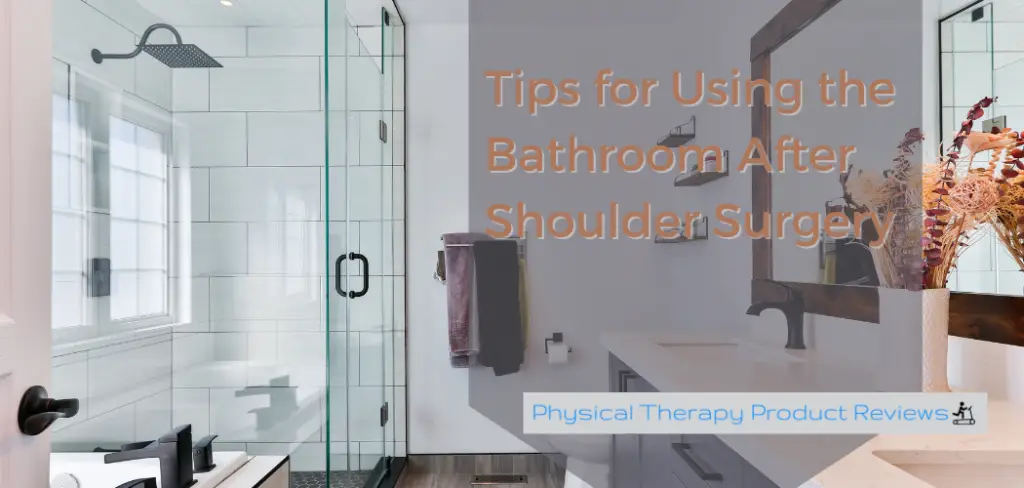 Sometimes it’s difficult getting through the day as it is, but when you’re dealing with mobility issues it can be downright discouraging. After having shoulder surgery, you may need to get creative in how you use the bathroom. You might be wondering what you will need to do after your surgery to safely use the bathroom.
Sometimes it’s difficult getting through the day as it is, but when you’re dealing with mobility issues it can be downright discouraging. After having shoulder surgery, you may need to get creative in how you use the bathroom. You might be wondering what you will need to do after your surgery to safely use the bathroom.
Preparing your home and bathroom pre-surgery will alleviate a lot of the stress and struggle after you have been operated on. There are many things you can do to make your daily tasks easier as you recover.
Making Your Bathroom Functional and Safe
It’s important to prepare your bathroom pre-surgery to reduce stress and avoid re-injury. These tips should make things a little easier for you to get around and expedite your recovery.
While this article mainly addresses bathroom accessibility, some of these suggestions apply to other parts of your home.
Clear the Way
Before your surgery, go through your entire home. Pay close attention to the pathways you frequent most often.
Clear any clutter or tripping hazards, including throw rugs or cords, to avoid accidents after your surgery. Re-injuring your shoulder could result in extended recovery time or even additional surgery.
Within Reach
Move items you need regularly in easy-to-reach reach places. You don’t want to be home alone and get injured because you were trying to get something that was out of your reach.
Preventing Toilet Accidents
Consider installing a raised toilet seat with handles for gripping. These seats allow you to lower slowly onto the toilet and keep you from having to reach or possibly hurt your shoulder.
Want to make it even easier on yourself? Choose a raised bidet toilet seat to aid in your cleaning process. These seats are great for those with limited mobility and range of motion.
Preventing Showering Accidents
Avoid a slip in the shower by using a shower stool and installing non-slip pads.
If you don’t already have one, consider upgrading to a handheld shower head. These are great because you can sit on the bench and use your good arm to spray yourself off. They also make it easy to keep your incision dry right after surgery.
Make showering even easier by using a body scrubber with a long handle. You’ll be able to reach everywhere without having to stretch too much.
Simplify Oral Care
You may not think that having shoulder surgery could affect how you brush your teeth, but it can. Just make a couple of simple swaps before surgery to keep your oral hygiene game on par.
- Switch to an electric toothbrush to reduce the back and forth motion.
- Switch to floss picks while you’re recovering. You’ll be able to floss with one hand.
Lower Your Ears
Try to get your hair cut and styled before your surgery. The easier your hair is to maintain, the better it will be for you. Long hair is a hassle to maintain with the use of one arm.
Shower After Shoulder Surgery
Other Things to Consider After Shoulder Surgery
Bathroom issues aren’t the only things to consider before surgery. Here are some other things to address before you go in.
Other things you can do to prepare yourself and your home after having shoulder surgery include:
- Getting help
- Pre-cooking and freezing meals
- Preparing your bed
- Laying out your clothes and more
If you would like to know more about how these items can aid your recovery process, continue reading.
6 Things to Aid Your Recovery Process After Shoulder Surgery
Some things to consider before surgery include:
Getting Help
This is especially important if you live alone. Try to line up some help, whether it be family and friends or a home health nurse.
For the first few weeks, you will be sore and have a limited range of motion. It will be necessary to have help with some of your daily activities and errands, as you won’t be able to drive.
Pre-cooking and Freezing Meals
You probably won’t feel up to cooking for awhile after surgery. To make it easier, pre-cook and freeze several meals that you can thaw out as needed.
Preparing Your Bed
After having shoulder surgery, it will be uncomfortable to sleep in your bed for a while. Some people opt for a recliner during the first few weeks. If you choose to sleep in your bed, you may want to consider purchasing some wedge pillows to prop yourself up with.
Layout Your Clothes
It will be much more difficult to get dressed after your surgery. Before surgery, pick out or purchase clothing that is easy to get in and out of.
Consider button-down shirts for the first couple of weeks. Once you have your clothing picked out, lay it out in an easy-to-reach place so you don’t have to dig for it later.
Medication Dispensing Box
After surgery, you will be on some medications. To keep them organized and be sure you are taking them properly, it is recommended that you have a box or bag to keep all of your medications together. You should also keep a list of instructions on hand.
If you have a bad memory, it may be a good idea to keep a chart in the medication box to check off when you have taken it. This will help you, and also anyone who is caring for you, to be sure you are properly medicated.
Laxatives
Speaking of medication, it is highly recommended that you keep laxatives on hand. Anesthesia, antibiotics, and post-operative pain medication can do a number on your digestive tract. Drink plenty of water to prevent constipation and belly pain.
Preventative Measures Will Ease Recovery Process
By planning you can prepare yourself and your home for what is to come. Discuss any questions or concerns you may have with your surgeon before surgery and try to get as many things prepared ahead of time. This will allow you to focus on recovering as quickly as possible.
Sources:
(https://www.jacksonvilleorthopaedicsurgeon.com/blog/10-must-haves-after-shoulder-surgery)
Other Great Rehab Related Articles
How to Stay Active After Cervical Fractures: Expert Tips and Advice
Dealing with Painful Stairs After Ankle Replacement Surgery
Walking After a Total Ankle Replacement: Tips for a Successful Recovery
Exercises While Non-Weight Bearing After Ankle Replacement: Elevation, AROM, Leg Raises, and More
Ankle Pain with Stairs: Causes and Home Treatment Options
5 Common Mistakes You’re Making After an Ankle Sprain
Disclaimer: The information provided in this post is for educational purposes only. This is not a substitute for a medical appointment. Please refer to your physician before starting any exercise program.







